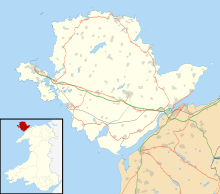Clegir Mawr
| Site of Special Scientific Interest | |
 The spotted rock-rose | |
| Location | West Gwynedd |
|---|---|
| Grid reference | SH 299 900 |
| Coordinates | 53°22′48″N 4°33′29″W / 53.3799°N 4.5580°W |
| Interest | Biological |
| Area | 9.6 hectares (24 acres) |
| Notification | 1961 |
Clegir Mawr is a Site of Special Scientific Interest (SSSI) in the community of Cylch-y-Garn in the north-west of the island of Anglesey, Wales. It is a stony coastal headland with an area just under 10 hectares (25 acres) and has been designated principally because of the occurrence of the spotted rock-rose (Tuberaria guttata) which is a nationally rare plant and also the county flower of Anglesey.
Site
[edit]The site includes two areas north of Church Bay (Porth Mawr) and includes coastal heath, coastal grassland, sea cliffs and scrub habitats with a total area of 9.6 hectares (24 acres).[1][2] Much of the area around the site is owned by the National Trust and includes the Isle of Anglesey Coastal Path.[3][4]
Importance
[edit]The principal feature is the spotted rock-rose which favours thin acidic soils on rocky ridgelines or steep slopes. The spotted rock-rose is only known to exist in nine British locations. One location is on the Lleyn Peninsula and the remaining seven are on Holy Island, Anglesey.[5] The flower blooms from June to August and the blooms last only a day.[6] The flower is the county flower of Anglesey.[7]
The conditions for the spotted rock-rose are also support a number of other species including sheep's fescue (Festuca ovina), common bent (Agrostis capillaris), squirreltail fescue (Vulpia bromoides), early hair-grass (Aira praecox), heather (Calluna vulgaris), bell heather (Erica cinerea), western gorse (Ulex gallii), spring squill (Scilla verna) and English stonecrop (Sedum anglicum).[5]
The uncommon golden-samphire (Inula crithmoides) is found on the sea cliffs, and the prickly sedge (Carex muricata) and dodder (Cuscuta epithymum) are also found on the site.[5]
References
[edit]- ^ "Clegir Mawr" (PDF) (Map). Natural Resources Wales. 1:10,000. Countryside Council for Wales. 23 January 1987 [Designated 1961]. Retrieved 26 April 2016.
- ^ "Clegir Mawr Site of Special Scientific Interest" (PDF). Natural Resources Wales. Countryside Council for Wales. Retrieved 26 April 2016.
- ^ "Landscape Character Area 4: North West Coast" (PDF). Isle of Anglesey County Council. 30 August 2011. p. 20. Retrieved 26 April 2016.
- ^ "Section 2: Porth Trwyn (Llanfaethlu) - Cemaes" (PDF). Coastal Path Route Description. Isle of Anglesey County Council. Retrieved 26 April 2016.
- ^ a b c "Anglesey: Clegir Mawr" (PDF). Site of Special Scientific Interest Citation. Countryside Council for Wales. 1986 [Designated 1961]. Retrieved 26 April 2016 – via Natural Resources Wales.
- ^ "Wildlife Highlights - Spotted Rock Rose". Visit Anglesey. Isle of Anglesey County Council. Retrieved 26 April 2016.
- ^ "The floral emblem of your county". The Daily Telegraph. 5 May 2004. Retrieved 26 April 2016.

